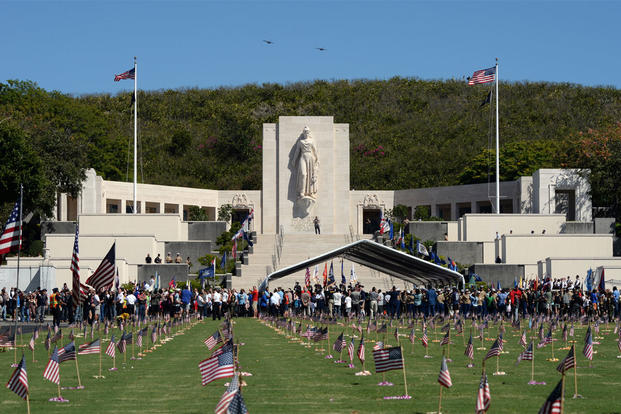WASHINGTON – To one man who survived Japan’s attack on Pearl Harbor in 1941, the past is a vista he looks back at with regret.
Raymond Emory, known as Ray, was a Navy seaman first class assigned to the USS Honolulu when the Japanese attacked. To honor his fellow service members who died that December 7, 74 years ago, Emory has spent the past 20 years walking the National Memorial Cemetery of the Pacific “day in and day out,” he told DoD News in a telephone interview.
Tending to a Sacred Site
The cemetery is set within a gently sloped, almost perfectly circular natural bowl, the remnant of ancient volcanic activity and the origin of its unofficial name, the “Punchbowl.” The crater’s Hawaiian name, Puowaina, translates to “Hill of Sacrifice,” and according to the memorial’s official website, the first known use of the site was as an altar where native Hawaiians “offered human sacrifices to pagan gods and ... killed violators of the many taboos.”
In the 1930s, the crater was used as a rifle range for the Hawaii National Guard. Toward the end of World War II, tunnels were dug through the rim of the crater for the placement of shore batteries to guard Honolulu Harbor and the south edge of Pearl Harbor.
It wasn’t until Jan. 4, 1949 that the first service member was interred at Punchbowl, and six months later the cemetery was opened for public visitation.
Emory said he made it a personal mission to correct the record for his fallen comrades, many of whom weren’t able to be identified at the time they were buried or had misspelled names inscribed on their grave markers.
“I got so involved with Punchbowl and the kids who got killed Dec. 7, that it’s taken up the last 20 years of my life,” the former sailor said.
‘Dignity, Respect, and Care’
Through a Defense Department-authorized effort now underway, many of the unidentified remains of sailors and Marines who died on the USS Oklahoma, which capsized in the first minutes of the attack after sustaining several torpedo hits, are now being analyzed for identification.
According to an April 14 DoD release, the remains of up to 388 unaccounted-for sailors and Marines associated with the Oklahoma will be exhumed this year. Upon disinterment, the remains will be transferred to the Defense POW/MIA Accounting Agency laboratory in Hawaii for examination.
Analysis of all available evidence, the release stated, indicates that most Oklahoma crew members can be identified upon disinterment.
In the release, Deputy Defense Secretary Bob Work said he and Defense Secretary Ash Carter will work tirelessly to ensure remains will be recovered, identified, and returned as expeditiously as possible.
“We will do so with dignity, respect and care,” he said. “While not all families will receive an individual identification, we will strive to provide resolution to as many families as possible.”
The disinterment policy applies to all unidentified remains from the National Memorial Cemetery of the Pacific and other permanent American military cemeteries. However, the policy does not extend to those sailors and Marines lost at sea or to remains entombed in U.S. Navy vessels serving as national memorials.
Lasting Memories of War
Emory said that the death and destruction at Pearl Harbor is long past, “but there hasn’t been a day in my life that I haven’t thought about that day.”
He said at first he wondered, “Who declared war on whom first, and where did they come from to get there so fast?”
He has since learned more about the facts behind the attack, he said, and is now pleased with the current identification effort’s progress to date.
A Deliberate Process, ‘Venerable Heroes’
Air Force Lt. Col. Melinda Morgan, director of public affairs for the Defense POW/MIA Accounting Agency, said the disinterment process involves 45 gravesites and 61 caskets at the cemetery.
“Once they are disinterred they are accessioned into the laboratory for the identification process to begin,” she said.
Gravesite operations are expected to take about six months, Morgan added, and the identification process can take up to five years.
She noted that DoD has made great strides in identifying remains recovered from “commingled” sites.
“For several years, the [Defense Department] has considered the complexities of [such] a decision,” she noted. “Recent advances in forensic science and technology, as well as family member assistance in providing genealogical information, have now made it possible to make individual identifications for many service members long-buried in graves marked ‘unknown.’”
Since 2003, DoD has contacted families, collected and analyzed DNA from over 80 percent of applicable USS Oklahoma family members, and has collected 90 percent of the available medical and dental records from the ship's crew, she said.
“DoD remains committed to fulfilling its obligation to achieve the fullest possible accounting for U.S. personnel lost in past conflicts,” Morgan said. “This is important to the families and these venerable heroes to be honored will full military-honors burials.”






























